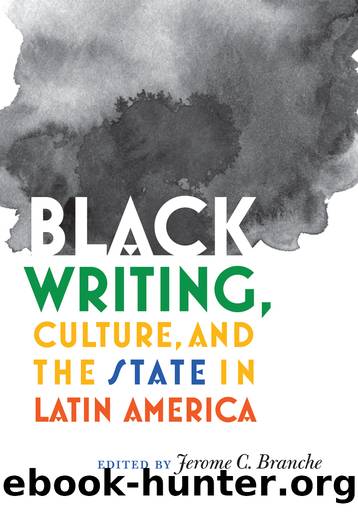Black Writing, Culture, and the State in Latin America by Unknown

Author:Unknown
Language: eng
Format: epub
Publisher: Vanderbilt University Press
Published: 2015-03-15T00:00:00+00:00
The juxtaposition of the physical labor of embroidering and forced childbearing is heightened by the disconnection and exploitation RoseGreen-Williams notes. However, Morejónâs use of the autobiographical voice in recounting the exploitation and the consequences point to the ways in which survival negotiated both objectification and agency. Here amid the exploitation is the female voiceârecounting not only the violence and invisibility, but also the ways in which these power dynamics were subject to shifts, as exemplified by the seemingly powerful masterâs death at the hands of another nobleman. What is also telling of the subjectâs recounting is the juxtaposition of marginalization and voiceâthe exploited subject whose son is invisibilized is placed at the center of her story through the focus on her first-person narration of events. The foregrounding of her firsthand account of her enslavement and survival is taken one step further following His Worshipâs death, when the female subject again engages in another action in her quest for freedom: her declaration âAnduveâ (I walked), which when placed alongside the other short versesââMe rebelé / Me sublevé / Trabajé mucho más / Me fui al monte / bajé de la Sierraâ (I rebelled / I rose up / I worked on and on / I left for the Hills / I came down from the Sierraâ) (200, 202)âare, as Gutiérrez notes, a part of âa continuous motion that purposely emphasizes the slave womanâs feelings of rebellion, coupled with an indomitable perseverance that persists throughout the four centuries covered in the poemâ (213).
Similarly, in Daughters of the Stone, Felaâs relationship with Don Tomás exemplifies the enslaved black womanâs vulnerability to the objectification, exploitation, and sexual violence of the slave master and the complex, myriad strategies she utilizes for survival and resistance. Here, Felaâs counter to the imposition of Don Tomásâs desire is an assertion of agency. She claims control of her body, placing the sexual exploitation that has been historically part of the colonial experience within the context of the strategies used by Afro-descendants, including the continuation of religious beliefs through cultural memory. As she emphatically declares: âMaybe the goddess was guiding her down this path. . . . At least this time she would have as much to do with what was about to happen as he did. She would not be taken. This time it would be her choice. . . . Fela felt nothing of what was occurring with her body. . . . She sent her senses beyond this place. . . . She would join Imo and the others. Oshun would be appeased and the ancestors would welcome herâ (46â47, 49).
Felaâs determination to wrest control of her body from Don Tomásâto give the sexual act a meaning outside of victimization and exploitation, to serve as a means to create a child who would be given a purpose and nameâconnect her with history and memory in a way that contrasts with the relationship between the enslaved black woman and His Worship previously highlighted in Morejónâs text. Her decision
Download
This site does not store any files on its server. We only index and link to content provided by other sites. Please contact the content providers to delete copyright contents if any and email us, we'll remove relevant links or contents immediately.
Harry Potter and the Goblet Of Fire by J.K. Rowling(3024)
Unfinished: A Memoir by Priyanka Chopra Jonas(2911)
Never by Ken Follett(2872)
The Man Who Died Twice by Richard Osman(2289)
Machine Learning at Scale with H2O by Gregory Keys | David Whiting(2264)
Fairy Tale by Stephen King(2058)
Will by Will Smith(2032)
Rationality by Steven Pinker(1760)
The Storyteller by Dave Grohl(1656)
The Dawn of Everything: A New History of Humanity by David Graeber & David Wengrow(1564)
The Dark Hours by Michael Connelly(1562)
The Stranger in the Lifeboat by Mitch Albom(1529)
Cloud Cuckoo Land by Anthony Doerr(1428)
The Becoming by Nora Roberts(1323)
Friends, Lovers, and the Big Terrible Thing by Matthew Perry(1321)
Crying in H Mart by Michelle Zauner(1312)
Einstein: His Life and Universe by Walter Isaacson(1311)
New Morning Mercies: A Daily Gospel Devotional by Paul David Tripp(1301)
A Short History of War by Jeremy Black(1295)
